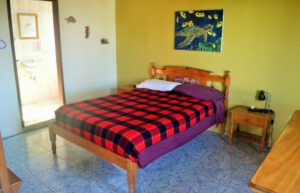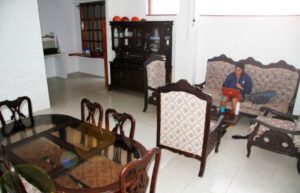GoEco > South America > Ecuador > Giant Tortoise and Sea Turtle Conservation in Galápagos

Join GoEco in the Galápagos and help care for ancient, giant tortoises and sea turtle nest conservation!
Program Highlights:
Your Schedule at a Glance (Minimum two-week commitment):
Arrival Day, Monday: Arrive at Baltra Airport (GPS) no later than 10:30 AM in order to catch the ferry to the island. The local team will meet you upon arrival and transfer you to your accommodations, where you can settle in and meet fellow volunteers.
Days 1-4, Tuesday-Friday: The typical workday is from 08:00 – 12:00. Depending on the workload and interest, there is a possibility to increase the working hours. Specific hours may vary depending on the tasks at hand. Volunteers will choose between either working with giant tortoises or for sea turtle nest conservation (during the season, best for the volunteers to discuss this with on-site staff to see if this is a possibility). You can view specific tasks for each placement under the “Volunteer Work” section of this page.
Days 5-6, Saturday-Sunday: Weekends are free for volunteers to relax, or explore the island and other islands.
Remaining Weeks: The remaining weeks will follow the schedule of volunteering Monday-Friday and having weekends free to spend how you wish (check out “Travel Highlights” below for suggestions!) Departures are on Sundays.







What’s Included




What’s not Included

The Galápagos Islands is a volcanic archipelago in the Pacific Ocean off the coast of mainland Ecuador and is one of the world’s leading locations for wildlife viewing. Its isolated landscape is home to a wide range of animal and plant species, many that cannot be found anywhere else in the world. Charles Darwin visited the islands in 1835, and his observation of Galápagos’ species later inspired his theory of evolution.

This project has been instrumental in the conservation of these ancient animals that were very close to extinction. At one time, a quarter million of these giants roamed these South American islands, but over time, that number diminished to around 3,000. Several factors were responsible for the decline, beginning with sailors and settlers hunting them for food.
As a volunteer on this project, you will work closely with the Galápagos National Park in their efforts to continue to conserve this indigenous species! During your time at the tortoise center, you will be a full-time member of the center’s staff, aiding in the conservation and care of these fascinating, ancient creatures. Volunteers taking part during the months from January to May will be assigned to work at either the tortoise breeding center (as described above) or with sea turtles, depending on the placement availability and the season. We will consider your preference when determining your placement, however, availability will be the deciding factor. Sea turtle nest monitoring tasks include walking the beach while looking for nests, turtles, and hatchlings. Actual sightings may be rare.
Tortoise center tasks may include:
Sea turtle conservation tasks may include:
A typical day: Your schedule is based on 20 hrs/week and can be extended to a regular 40 hr work week. You will work from Monday – Friday, from 7.30AM – 11.30AM. This may change depending on the tasks at hand.
Important Note for the 2024 season: The year 2024 marks an El Niño phase, influencing temperature fluctuations in the Equatorial Pacific. El Niño events, occurring approximately every seven years, disrupt the Humboldt Current, leading to warmer waters along the shores of South America. While we haven’t monitored sea turtle nesting during El Niño on this beach before, we expect potential effects on tides and nesting locations. Despite uncertainties, long-term data collection is crucial for understanding and managing future events. If you choose to volunteer during this time, you’ll contribute to essential baseline turtle nesting data, observing unique wildlife behaviors during El Niño, including changes in sea and land species.









A volunteer visa is no longer required. Volunteers enter Ecuador on a tourist visa for 90 days and the local team will provide you with a Galapagos visa.
Please note this project’s minimum requirements:

The Galápagos Islands are one of the world’s most popular tourist destinations for wildlife viewing. Made famous by the scientist Charles Darwin, these South American islands are home to species that many people are familiar with, such as the blue-footed booby birds and giant tortoises. There is much to be seen on a trip to these islands, and a few suggestions are listed below.
Darwin Lake
Also on the island, Darwin Lake is a saltwater lagoon that has twice the amount of salt on the surrounding ocean.
Tagus Cove
From the cliffs surrounding Darwin Lake, volunteers can take a panga ride to Tagus Cove where there is the opportunity to see, and even snorkel with, indigenous marine life such as Galapagos penguins!
Tortuga Bay
For volunteers who wish to island hop, Isla Santa Cruz, to the right of the island, is an excellent choice. Tortuga Bay is one of the most popular and beautiful beach destinations in all the Galápagos Islands and is in southern Isla Santa Cruz. There are sharks, marine iguanas and occasionally flamingos in the Bay.

© 2022 GOECO | All rights reserved
Develop & Design | Msite